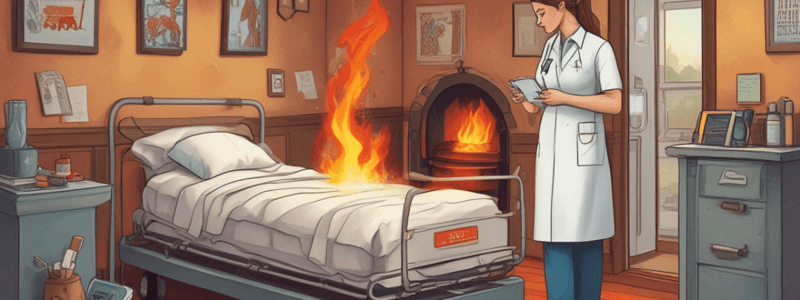Podcast
Questions and Answers
What is the primary benefit of setting the hot water temperature at 140°F in terms of home fire safety?
What is the primary benefit of setting the hot water temperature at 140°F in terms of home fire safety?
- It prevents scald injuries. (correct)
- It reduces the risk of fires caused by faulty wiring.
- It reduces the risk of fires caused by unattended cooking.
- It reduces the risk of electrical fires.
What type of burn is most likely to result from an electrical injury?
What type of burn is most likely to result from an electrical injury?
- Superficial burn
- Partial-thickness burn
- Chemical burn
- Full-thickness burn (correct)
What would the nurse expect to find when assessing a patient with a partial-thickness burn?
What would the nurse expect to find when assessing a patient with a partial-thickness burn?
- Exposed fascia
- Intact nerve endings and blisters (correct)
- Dry, leathery skin
- Exposed muscles
What is the primary reason the nurse should anticipate the need for endotracheal intubation in the patient with burns to the head, neck, and chest?
What is the primary reason the nurse should anticipate the need for endotracheal intubation in the patient with burns to the head, neck, and chest?
What is the primary fluid and electrolyte shift that occurs during the early emergent phase of a burn injury?
What is the primary fluid and electrolyte shift that occurs during the early emergent phase of a burn injury?
What is the primary reason the nurse should encourage regular home fire exit drills?
What is the primary reason the nurse should encourage regular home fire exit drills?
What is a potential complication of administering large volumes of fluid rapidly to a burn patient?
What is a potential complication of administering large volumes of fluid rapidly to a burn patient?
What is the priority intervention for wound care in a patient with a 25% TBSA burn?
What is the priority intervention for wound care in a patient with a 25% TBSA burn?
What is essential for effective pain management in a burn patient?
What is essential for effective pain management in a burn patient?
What is a therapeutic measure used to prevent hypertrophic scarring during the rehabilitation phase of burn recovery?
What is a therapeutic measure used to prevent hypertrophic scarring during the rehabilitation phase of burn recovery?
What is the first action the nurse should take when meeting with a patient recovering from second- and third-degree burns?
What is the first action the nurse should take when meeting with a patient recovering from second- and third-degree burns?
What is necessary to maintain a positive nitrogen balance in a major burn patient?
What is necessary to maintain a positive nitrogen balance in a major burn patient?
Flashcards are hidden until you start studying
Study Notes
Home Fire Safety
- The nurse should encourage regular home fire exit drills as a prevention strategy.
Burn Injuries
- Sunburn is the least likely to result in a full-thickness burn.
Partial-Thickness Burn Assessment
- The nurse would expect to find blisters, intact nerve endings, and a red, shiny, wet appearance when assessing a patient with a partial-thickness burn.
Burn Patient Assessment
- If the nurse auscultates wheezes throughout the lung fields and then finds decreased breath sounds, the most appropriate action is to anticipate the need for endotracheal intubation and notify the provider.
Fluid and Electrolyte Shifts
- During the early emergent phase of a burn injury, fluid and electrolyte shifts include the movement of sodium and water into the interstitial space.
Nutrition for Burn Patients
- To maintain a positive nitrogen balance in a major burn, the patient must eat a high-protein, high-carbohydrate diet.
Wound Care
- The nurse's priority intervention for wound care would be to observe the wound for signs of infection during dressing changes.
Pain Management
- Pain management for the burn patient is most effective when using a pain rating tool, informing the patient about and having control over the management of pain, and using a multimodal approach (e.g., sustained-release and short-acting opioids, NSAIDs, adjuvant analgesics).
Rehabilitation Phase
- A therapeutic measure used to prevent hypertrophic scarring during the rehabilitation phase is applying pressure garments.
Discharge Planning
- The first action the nurse should take when meeting with the patient is to review the patient's current health care status and readiness for discharge to home.
Studying That Suits You
Use AI to generate personalized quizzes and flashcards to suit your learning preferences.




